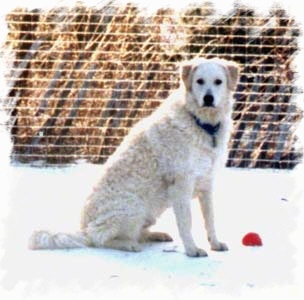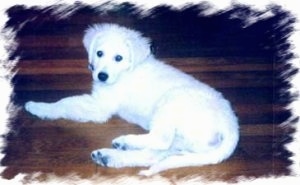Aidan the Kuvasz, photo courtesy of Kilde's Kennel
KOO-vahz 
Kuvaszok = koo v-ah-sawk
The Kuvasz is a fearless, bold flock guardian. In the show ring the head is considered the most beautiful part of the dog. The muzzle is in proportion to the head. The stop is well-defined, not abrupt. The nose is black with large nostrils. The lips are black. The ears are thick, well set back, V-shaped and slightly rounded at the tip. The dark brown eyes are almond-shaped, set well apart. The body is medium boned and slightly longer than it is tall. The tail is carried low, and is not docked, reaching at least to the hocks. When the dog is excited the tail is slightly raised. The feet are well padded and the dewclaws on the front legs are not usually removed, but the ones on the back legs are. The neck has a mane that reaches the chest. The hair is shorter on the feet and head, but on the body and legs it is wavy and can be as much as 4-6 inches (10-15 cm) long. The medium-length, double coat comes in white and ivory. The skin is heavily pigmented. The coat can be anywhere from wavy to straight. The undercoat is thick.
The Kuvasz is intelligent and can be a good family dog if it has an owners who know how to display a natural, firm authority over it, is socialized, trained thoroughly, and raised with children from the start, but it is not recommended for most families. The Kuvasz was bred to be a livestock guardian and therefore is very territorial with strong protective instincts. It is an outstanding herder and defender of the flock against wolves. They make excellent guard dogs and are easy to housebreak, but they are large in size and with their protective instincts extra owner responsibility is required. This breed will fiercely defend his people and territory. The Kuvasz is devoted to his family, forming a strong bond, however if it does not see the humans as being stronger minded than itself, it will be stand-offish even with them.
If the dog is going to live with children, it is best, if possible, to select a Kuvasz pup and have the dog raised with the children. The children need to be taught how to be pack leaders. While the Kuvasz bonds well with children in the family, other children need to be monitored. You do not want the Kuvasz to believe he needs to protect your child from another should the children get into a scuffle. It is recommended to not leave them unsupervised.
As with all canine animals, the dominancy level varies from dog to dog, even in the same litter. However this breed is in general more dominant than most because of its inbred flock guard abilities. This means they will be prone to being reserved with strangers and extra care needs to be given in extensively socializing them, most effectively when they are still puppies. Puppies should be handled a lot by strangers. Owners should never let the puppies jump on or chew on humans. They should be taught to heel on a lead right from the start and learn to enter and exit all door and gateways after the humans.
While puppies will easily accept new humans and animals, as the dog grows this will change. Adolescent dogs will test authority often. This is why it is very important to establish leadership right from the start so you are able to communicate with the young dog that it is not to fight with new animals that enter onto the property and is to accept unknown humans. You cannot train out the guarding instinct in this breed; it will guard your home if they feel a valid threat, however you can teach it to respect your authority.
This breed is bold, brave and fearless. They were bred to work independently, which means they are not easy to obedience train. Training should never be harsh, but rather needs to be calm but firm, by a confident experienced, dominant person. The handler needs to have an air of natural authority to them. This dog needs to be controlled with the mind, not the hand. The dog will be looking for a leader and owners need to be stronger minded than the dog. They will be willful with meek or passive owners. All members of the family need to be taught how to handle the dog right from puppyhood. Owners need to teach the dog to accept welcomed guests and to look to the owner for leadership, rather than the dog expecting the owners to look to him for leadership. The biggest key to training a Kuvasz is to understand the nature of the breed as an independent guardian. It is very important NOT to use harsh training methods, but rather calm, firm methods.
Kuvasz that are going to work as flock guards need special training. An expert should be called in to assist if you are not familiar with the process. Puppies that are about 6 weeks old should not live inside the home with the humans, but rather with the flock they will be called upon to guard, so they can form a bond. When they are raised to work as the flock guardian they were bred to be they will be very reserved with strangers and territorial. A police dog trainer would be exactly the wrong kind of trainer to use. A police dog type of temperament is not what the Kuvasz is. They make terrible police dogs because they are too independent. They judge, not you, what force is necessary in any situation, based on what they believe. That comes out of instinct, and then what they are "taught." They are really remarkable judges of how forceful to be in a situation. You need to "teach" the Kuvasz, you don't "train" them. This does not mean physically force; you must understand that "impression" is what creates dominance. The same Kuvasz that will drive off a wolf, bear, etc., without hesitation, will stand by in the field, helping a ewe with a lamb’s delivery and making sure the lamb can find its mother. The key to successful introduction into livestock guarding seems to be an experienced older dog to guide the puppy. If not, then the owner will have his work cut out for him during the first six months to a year. You will need a lot of patience and some guidance from other people with experience. Once bonded to the livestock, the Kuvasz is going to make sure that nothing, ever, can harm them. That is their nature. It is the details along the way to that balance (the growing up process) that is stressful for the owner.
Height: Males 28 - 30 inches (71 - 76 cm) Females 26 - 28 inches (66 - 71 cm)
Weight: Males 100 - 115 pounds (45 - 52 kg) Females 70 - 90 pounds (32 - 41 kg)
Prone to hip dysplasia (check with your breeder to make sure the parents have hip clearance). Some minor issues are osteochondritis dissecans (a disease causing lameness from inflammation of the shoulder joints), hypertrophic osteodystrophy, skin problems and allergic reactions. This breed may drool and slobber.
The Kuvasz is not recommended for apartment life. It is fairly active indoors and does best with at least a large yard. Do not leave this dog alone in the backyard for long stretches of time, as he may become destructive. Vigorous exercise should help with this. The Kuvasz should never be left outside all tied up, for this could lead to viciousness. It will do best in a large enclosed yard. It especially enjoys cold weather and can live outdoors in temperate to cold climates as long as it has a doghouse and fresh water, but will do best if allowed access to both the house and yard. The Kuvasz's thick coat makes him very uncomfortable in warm weather or humid conditions; it should always have plenty of shade and fresh water.
The Kuvasz needs vigorous daily exercise. If it is not actively working as a flock guardian it needs to be taken on a daily, long brisk walk or jog. While out on the walk the dog must be made to heel beside or behind the person holding the lead, as in a dog's mind the leader leads the way, and that leader needs to be the human. Exercising should help with chewing or digging problems—in hopes that it will tire the dog out.
About 10-12 years
About 6 to 8 puppies
The thick, medium coat of the Kuvasz should be brushed weekly. Avoid bathing this breed, as the coat naturally sheds dirt and bathing will remove the oils that give the coat this property. The more you bathe this dog the more it will need to be bathed! Instead of bathing, the dog should be brushed frequently. Some people rub talcum powder or cornstarch into the coat and then brush it out again as a cleaning strategy. Check behind the ears for matting. In cold climates it will only shed seasonally, but in warmer climates, it will most likely shed all year around.
The Kuvasz originated in Tibet, but developed into the breed it is today in Hungary. Some authors claim that the Kuvasz has been known since the age of the Huns. Others describe it as a sheepdog that accompanied the Turkish refugees and their flocks fleeing the Mongols into Hungary in 1200. Its name in Turkish means "protector." The dog was owned by royalty in the fifteenth century in the court of King Matyas I, who lived from 1458-1490. The King claimed to only trust his Kuvasz dogs and not people. The Kuvasz were often given as royal gifts. At the death of the King, the Kuvasz returned to being a flock guardian throughout the medieval period. They were also used to hunt big game such as wild boar and bear. As Hungarian herdsmen traveled with their cattle and dogs, Kuvasz contributed to the development to the Maremma Sheepdog, Great Pyrenees, Polish Tatra Sheepdog and the Anatolian Shepherd, which are all flock guards. By the end of World War ll the breed was almost extinct. A handful of breeders worked to bring the breed back to safe numbers.
Flock Guard, AKC Working
Aidan the Kuvasz with one of the male pups—photo courtesy of Kilde's Kennel
Nic with his Kuvasz guardians Beauty and Aidan—photo courtesy of Kilde's Kennel
Photo courtesy of Kilde's Kennel
Kuvasz puppy—Photo courtesy of Kilde's Kennel
Kuvasz puppy—Photo courtesy of Kilde's Kennel

This is Tirza standing over Remi as a puppy. Photo courtesy of Steve Kovacs

This beautiful Kuvasz is named Denali. Photo courtesy of Dogs & Designs

This is Denali as a puppy at 8 weeks old. Photo courtesy of Dogs & Designs